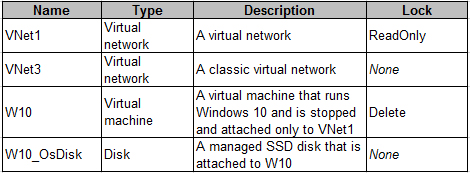

You have an Azure subscription that contains 10 virtual machines.
You need to ensure that you receive an email message when any virtual machines are powered off, restarted, or deallocated.
What is the minimum number of rules and action groups that you require?
Correct Answer:
C
🗳️
An action group is a collection of notification preferences defined by the user. Azure Monitor and Service Health alerts are configured to use a specific action group when the alert is triggered. Various alerts may use the same action group or different action groups depending on the user's requirements.
References:
https://docs.microsoft.com/en-us/azure/monitoring-and-diagnostics/monitoring-action-groups
You have an Azure subscription that contains two resource groups named RG1 and RG2. RG2 does not contain any resources. RG1 contains the resources in the following table.
Which resource can you move to RG2?
Correct Answer:
B
🗳️
When moving a virtual network, you must also move its dependent resources. For example, you must move gateways with the virtual network. VM W10, which is in Vnet1, is not a dependent resource.
Incorrect Answers:
A: Managed disks don't support move.
C: Virtual networks (classic) can't be moved.
D: Virtual machines with the managed disks cannot be moved.
References:
https://docs.microsoft.com/en-us/azure/azure-resource-manager/resource-group-move-resources#virtual-machines-limitations
You have 100 Azure subscriptions. All the subscriptions are associated to the same Azure Active Directory (Azure AD) tenant named contoso.com.
You are a global administrator.
You plan to create a report that lists all the resources across all the subscriptions.
You need to ensure that you can view all the resources in all the subscriptions.
What should you do?
Correct Answer:
C
🗳️
The New-AzureADUserAppRoleAssignment cmdlet assigns a user to an application role in Azure Active Directory (AD). Use it for the application report.
References:
https://docs.microsoft.com/en-us/powershell/module/azuread/new-azureaduserapproleassignment?view=azureadps-2.0
Note: This question is part of a series of questions that present the same scenario. Each question in the series contains a unique solution that might meet the stated goals. Some question sets might have more than one correct solution, while others might not have a correct solution.
After you answer a question in this section, you will NOT be able to return to it. As a result, these questions will not appear in the review screen.
You have an Azure subscription named Subscription1. Subscription1 contains a resource group named RG1. RG1 contains resources that were deployed by using templates.
You need to view the date and time when the resources were created in RG1.
Solution: From the Subscriptions blade, you select the subscription, and then click Programmatic deployment.
Does this meet the goal?
Correct Answer:
B
🗳️